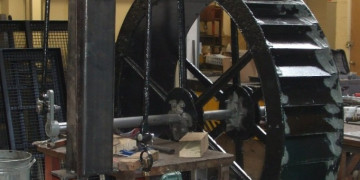Case study: Claydon Canal Lockgates
Restoration of a pair of cast iron lock gates for the Canal & River Trust.
Dorothea Restorations were commissioned to repair and strengthen a pair of lock gates situated at Claydon Lock, Oxford. The main hinge stile had several cracks in it from repeated narrow boat collisions and required strengthening/repairing. The gates were blast cleaned to SA 2.5 and an epoxy primer applied. This removed all surface debris and enable the full extent of repairs to be evaluated. The cracks were metal-stitched as shown in the photographs. Reinforcing curved steel plates were installed on the inside of the hinge stile to add additional strength. These were drilled and tapped into the existing cast iron, and bedded on an adhesive mastic to ensure a water tight seal betwenn the two materials. The gates received another 3 paint coats using a two pack epoxy system.
A Little History of Britain’s Waterways Heritage
The control of waterways by means of canals can be dated back as far as 4000BC and attributed to the ancient civilisation of Egypt. However, Europe’s first summit-level canal dated to the late 1300s and the first mitre lock and chamber gate canal was built in Milan in the 1400’s.
Britain had a few short canals in the 15th and 16th centuries but the real boom didn’t occur until the 1700’s. With the birth of the industrial revolution and a remarkable growth of trade in Britain so too was the first industrial waterway constructed in Britain. The volume of goods the new canals could carry across Britain and out to sea saw Britain become the first global industrial power boosting economy into the Victoria era. By 1850, there were almost 5000 miles of canal waterways in Britain.
However, with the demise of traditional industrious works such as coal and textiles, following WW1 and WW2, commercial use of canals was put to bed until eventually in the 70’s to the use of canals for leisure was born.
Construction of the Oxford Canal began in 1769 north of Coventry. Eagerly promoted by Wedgewood and the Gilbert Brothers, by 1777, it had reached as far as Claydon. Claydon Locks, a flight of five that starts the Canals southern journey, were built by Samuel Simcock, who some argue can be attributed for the somewhat unnecessary meandering course the canal now takes.
Back to case studies












